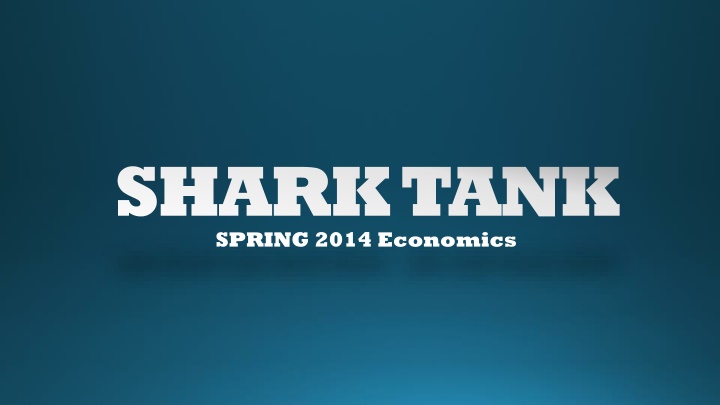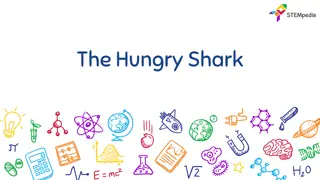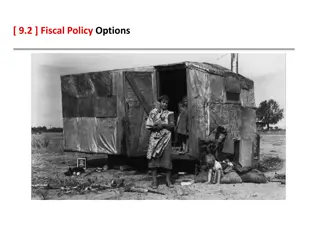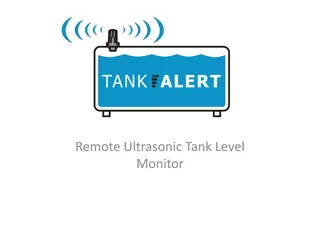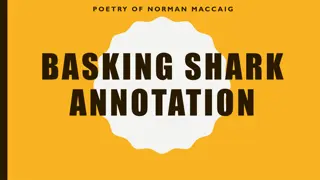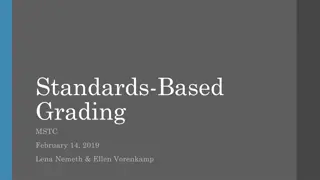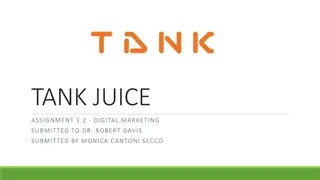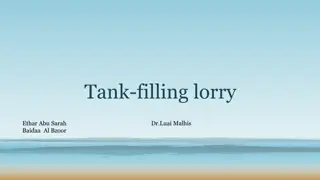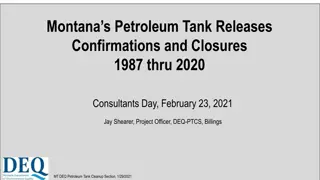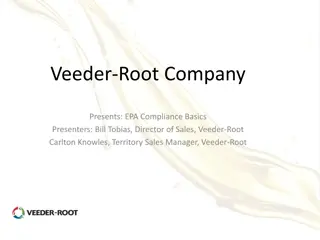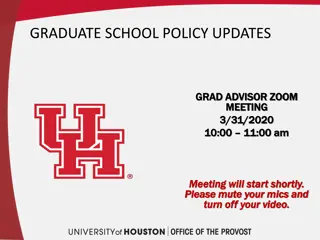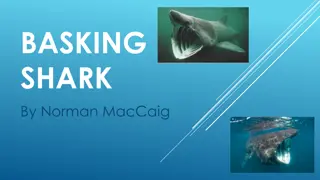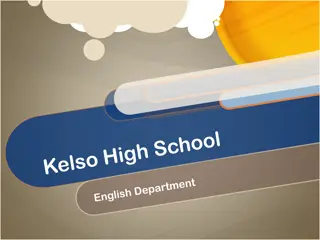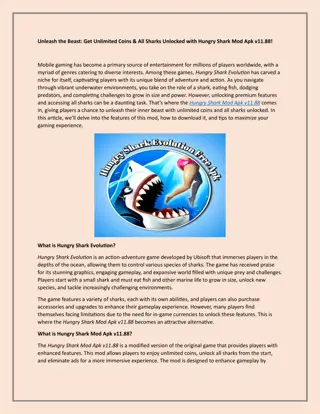Shark Tank Spring 2014 Economics - Business Plan and Presentation Grading Criteria
In the Shark Tank Spring 2014 Economics, the grading criteria were based on a 60% evaluation of the Business Plan and a 40% assessment of the Presentation. The Business Plan required thorough answers to questions ranging from product details to funding strategies and legal requirements, while the Presentation was significant for articulating the proposed business idea effectively. The rubric outlined specific expectations for organization, sources, draft quality, paragraph construction, internet use, and information depth, emphasizing the importance of a well-prepared and comprehensive business proposal in the competitive environment.
Download Presentation

Please find below an Image/Link to download the presentation.
The content on the website is provided AS IS for your information and personal use only. It may not be sold, licensed, or shared on other websites without obtaining consent from the author.If you encounter any issues during the download, it is possible that the publisher has removed the file from their server.
You are allowed to download the files provided on this website for personal or commercial use, subject to the condition that they are used lawfully. All files are the property of their respective owners.
The content on the website is provided AS IS for your information and personal use only. It may not be sold, licensed, or shared on other websites without obtaining consent from the author.
E N D
Presentation Transcript
SHARK TANK SPRING 2014 Economics
How it will be graded 60% Business Plan 40% Presentation
BUSINESS PLAN ANSWER THE FOLLOWING QUESTIONS 1. What are you going to make, who is going to buy it, why will it work in today s economy? 2. Is there an existing business that has done this already? Why is yours better, different or suited for your market? 3. What would be a good location choice and why? What type of consumer are you targeting? Where do they shop? Explain 4. Find a real place that is on the market, its price, sqft, and address. Include photos in your ad. 5. How much would you charge for your product or service? What is your cost, markup% and projected annual profit? 6. How would you advertise it? Describe the way you would advertise, how much it would cost and a sample. 7. How will the profits be shared? Goes with the type of business you selected. What are your payout percentages? 8. Will your business have to pay taxes? Will you have individual income taxes? 9. How are you going to fund it? Loans? A silent partner? A venture capitalist? Going Public? 10. What is the collateral going to be? What will you risk? 11. Will you need workers? How many workers? Are you the manager? Provide a sample schedule for your employees. 12. What legal paperwork or documents are needed to get started? Sole Proprietorship, Partnership or Inc.? 13. Does it require any certifications or licensing? TABC? HVAC? ATF? 14. Add more stuff that I couldn t think of .sell this thing!
Business Plan Rubric CATEGORY 4 Information is very organized with well- constructed paragraphs and subheadings. 3 Information is organized with well-constructed paragraphs. 2 Information is organized, but paragraphs are not well-constructed. 1 The information appears to be disorganized. 8) Organization All sources (information and graphics) are accurately documented in the desired format. All sources (information and graphics) are accurately documented, but a few are not in the desired format. All sources (information and graphics) are accurately documented, but many are not in the desired format. Some sources are not accurately documented. Sources Detailed draft is neatly presented and includes all required information. Draft includes all required information and is legible. Draft includes most required information and is legible. Draft is missing required information and is difficult to read. First Draft All paragraphs include introductory sentence, explanations or details, and concluding sentence. Most paragraphs include introductory sentence, explanations or details, and concluding sentence. Paragraphs included related information but were typically not constructed well. Paragraphing structure was not clear and sentences were not typically related within the paragraphs. Paragraph Construction Successfully uses suggested internet links to find information and navigates within these sites easily without assistance. Usually able to use suggested internet links to find information and navigates within these sites easily without assistance. Occasionally able to use suggested internet links to find information and navigates within these sites easily without assistance. Needs assistance or supervision to use suggested internet links and/or to navigate within these sites. Internet Use All topics are addressed and all questions answered with at least 6 sentences about each. All topics are addressed and most questions answered with at least 5 sentences about each. All topics are addressed, and most questions answered with 4 sentence about each. One or more topics were not addressed. Amount of Information Information clearly relates to the main topic. It includes several supporting details and/or examples. Information clearly relates to the main topic. It provides 1-2 supporting details and/or examples. Information clearly relates to the main topic. No details and/or examples are given. Information has little or nothing to do with the main topic. Quality of Information
PowerPoint Presentations CATEGORY 4 Background does not detract from text or other graphics. Choice of background is consistent from card to card and is appropriate for the topic. 3 Background does not detract from text or other graphics. Choice of background is consistent from card to card. 2 Background does not detract from text or other graphics. 1 Background makes it difficult to see text or competes with other graphics on the page. Background Presentation shows considerable originality and inventiveness. The content and ideas are presented in a unique and interesting way. Presentation shows some originality and inventiveness. The content and ideas are presented in an interesting way. Presentation shows an attempt at originality and inventiveness on 1-2 cards. Presentation is a rehash of other people's ideas and/or graphics and shows very little attempt at original thought. Originality All content throughout the presentation is accurate. There are no factual errors. Most of the content is accurate but there is one piece of information that might be inaccurate. The content is generally accurate, but one piece of information is clearly flawed or inaccurate. Content is typically confusing or contains more than one factual error. Content - Accuracy Font formats (e.g., color, bold, italic) have been carefully planned to enhance readability and content. Font formats have been carefully planned to enhance readability. Font formatting has been carefully planned to complement the content. It may be a little hard to read. Font formatting makes it very difficult to read the material. Text - Font Choice & Formatting Information is organized in a clear, logical way. It is easy to anticipate the type of material that might be on the next card. Most information is organized in a clear, logical way. One card or item of information seems out of place. Some information is logically sequenced. An occasional card or item of information seems out of place. There is no clear plan for the organization of information. Sequencing of Information Presentation is 7 minutes long Presentation is 6 minutes long Presentation is 4-5 minutes long Presentation is 1-4 minutes long Presentation Time Student is completely prepared and has obviously rehearsed Student seems pretty prepared but might have needed a couple more rehearsals. The student is somewhat prepared, but it is clear that rehearsal was lacking. Student does not seem at all prepared to present. Preparedness
TRIFOLD POSTER PRESENTATION CATEGORY 4 The poster includes all required elements as well as additional information. 3 All required elements are included on the poster. 2 All but 1 of the required elements are included on the poster. 1 Several required elements were missing. Required Elements Graphics are all in focus and the content easily viewed and identified from 6 ft. away. Most graphics are in focus and the content easily viewed and identified from 6 ft. away. Most graphics are in focus and the content is easily viewed and identified from 4 ft. away. Many graphics are not clear or are too small. Graphics -Clarity All graphics are related to the topic and make it easier to understand. All graphics are related to the topic and most make it easier to understand. All graphics relate to the topic. Graphics do not relate to the topic. Graphics - Relevance All content throughout the presentation is accurate. There are no factual errors Most of the content is accurate but there is one piece of information that might be inaccurate. The content is generally accurate, but one piece of information is clearly flawed or inaccurate. Content is typically confusing or contains more than one factual error Content - Accuracy Title can be read from 6 ft. away and is quite creative. Title can be read from 6 ft. away and describes content well. Title can be read from 4 ft. away and describes the content well. The title is too small and/or does not describe the content of the poster well. Title Several of the graphics used on the poster reflect a exceptional degree of student creativity in their creation and/or display. One or two of the graphics used on the poster reflect student creativity in their creation and/or display. The graphics are made by the student, but are based on the designs or ideas of others. No graphics made by the student are included. Graphics - Originality Presentation is 7 minutes long Presentation is 6 minutes long Presentation is 4-5 minutes long Presentation is 1-4 minutes long Presentation Student is completely prepared and has obviously rehearsed Student seems pretty prepared but might have needed a couple more rehearsals The student is somewhat prepared, but it is clear that rehearsal was lacking Student does not seem at all prepared to present. Preparedness
DOING YOUR HOMEWORK The following slides are going to be your biggest asset in helping you develop your product or business.
ANALYZE THE MARKET Consider which segment of the local (and/or international) population will be seeking to use your products or services. This needs to be more than mere guesswork and involves doing accurate and intelligent research. You need to analyze secondary research collected by outside observers, as well as getting primary research that you collect yourself, with your own methods and observations.
ANALYZE THE MARKET Is there a viable market for the product or service you want to sell? How old are your potential customers? What do they do for a living? Is your product or service attractive to a particular ethnic or economic population? Will only wealthy people be able to afford it? Does your ideal customer live in a certain type of neighborhood or area?
Establish the size of your Establish the size of your potential market. potential market. It's important to be as specific as possible in regard to your market and your product. If you want to start a soap business, for example, you may believe that every dirty body needs your product, but you can t start with the entire world as your initial market. Even if you ve developed such a universally needed item as soap, you need to identify a smaller, more targeted customer group first, such as children under eight who might like bubblegum scented bubble bath, or soap made for mechanics.
Establish the size of your Establish the size of your potential market. potential market. How many car mechanics are in need of soap in any given community? How many children in the United States are currently under the age of eight? How much soap will they use in a month or a year? How many other soap manufacturers already have a share of the market? How big are your potential competitors?
Identify company needs What will you require to get started? Whether you want to buy an existing company with 300 employees or start your own by adding an extra phone line to your home office desk, you need to make a list of the materials you ll need. Some may be tangible, such as five hundred file folders and a large cabinet in which to store them all. Other requirements may be intangible, such as time to create a product design or to do market research on potential customers.
Prepare product samples. Prepare product samples. If you re going to build a better mousetrap, you may have constructed a prototype out of used toothpaste tubes and bent paperclips at home, but you ll need a sturdier, more attractive model to show potential investors. What exactly will your mousetrap look like? What materials will you need? Do you require money for research and development to improve on your original toothpaste tube and paper clip construction? Do you need to hire an engineer to draw up accurate manufacturing designs? Should you patent your invention? Will you need to investigate federal safety standards for mousetraps?
Research possible Research possible locations for your business. locations for your business. Call a real estate broker and look at actual retail spaces in the neighborhood where you d like to open your restaurant. Make a chart of the most expensive and least expensive sites by location and square footage. Then estimate how much space you require and how much money you ll need to allow for rent.
Determine your start Determine your start- -up cost. cost. Make a list of all the tangible and intangible resources you need to get your business going. The total estimated price of all of these items will become your start-up cost whether you re buying highly sophisticated computers or simply installing a new telephone line on your desk. If there s any item in your estimates that seems unreasonably high, research other alternatives. But keep in mind that it s better to include every element you truly need along with a reasonable estimate of the cost of each item, so you don t run out of money or default on your loans. up Be honest and conservative in your estimates, but also be optimistic.Don't aim for the best of everything at the beginning. You can forgo the expensive trimmings of an office of a more well-established company and stick to the basics at the beginning. Get what is affordable, works and is actually needed and don't buy frills.
Put yourself in the shoes of Put yourself in the shoes of potential investors. potential investors. Ask yourself, If I were going to invest X amount of dollars into a concept or idea, or even a product, what would I want to know? Gather as much helpful and credible information as you can. Depending on your product, you may need to search long and hard for relevant information.
Identify potential Identify potential investors. investors. Banks and other funding sources don t lend money because people with interesting business ideas are nice. They follow specific guidelines, such as the Risk Management Association (R.M.A) database, which are designed to ensure that they will make money by investing in or lending to your business. Lenders will typically look to the company's Capital, Capacity, Collateral, Conditions, and Character or what is known as the 5C's of lending when underwriting a loan. You'll need to have covered all these bases well before seeking funding.
